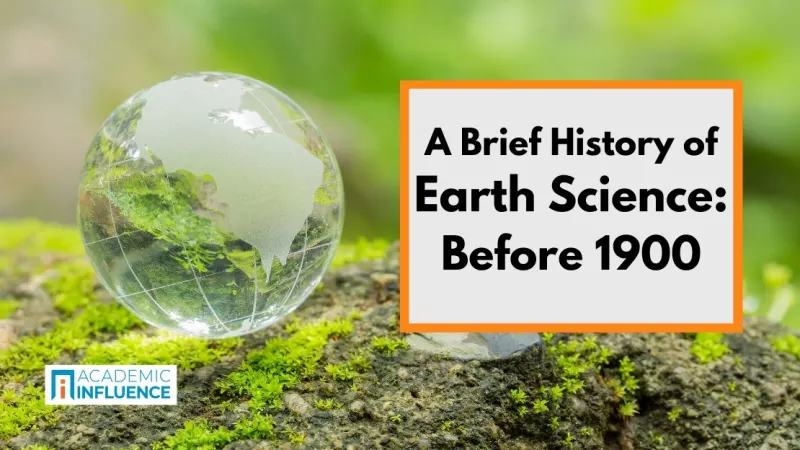A Brief History of Earth Sciences: Before 1900

We explore the field of earth science before 1900.
A good first step in tracing the early history of the earth sciences is to recognize that this academic and professional field actually encompasses a broad range of disciplines and that each of those disciplines has a fascinating and unique beginning. of these disciplines, the one that widely used the scientific method the earliest was geology and, more specifically, mineralogy, which is the study of the structure, chemistry and physical properties of minerals. Humans have prized many kinds of minerals, particularly gems, precious metals, and metals useful for tools, since before the dawn of civilization so it’s no surprise that, as the scientific method gained popularity in the 16th and 17th centuries, mineralogy would be an area of great interest and activity.
A big name in early mineralogy, and “founder of modern geologic thought” is the Danish priest-scientist and developer of the first law of crystallography, Nicolas Steno (1638-1686). Though the son and step-son of a goldsmith, Steno’s arrival in the nascent scientific field of mineralogy was by way of paleontology–he noticed similarities between so-called “tongue-stones” and shark’s teeth. He also wrote rules of stratigraphy that James D. Hutton (1726-1797) used a century later to formulate what we now call “geologic time”.
Charles Lyell (1797-1875), known best for his influence on Darwin’s thinking, was born the year Hutton died. Many of Hutton’s concepts of deep time worked their way into Lyell’s thinking. The interplay between Hutton’s thoughts and those of Lyell highlights an ongoing debate in Earth Sciences: catastrophism vs. gradualism. Lyell dismissed Hutton’s views as emphasizing catastrophism to too large a degree. Lyell’s gradualism, though extremely influential, didn’t completely win the day however, as seen in the more recent debate over plate tectonics and the Chicxulub impactor.
From Lyell’s time to the beginning of the 20th century, there was an explosion of scientific development in several other earth sciences. For example, two months after Lyell died in 1875. For example, two months after Lyell died, polymath Francis Galton published the first weather map. Then, in 1876, the HMS Challenger returned to England after a 1250-day expedition to map ocean features, thus inaugurating the scientific field of oceanography. Seventeen years later, the meter was defined as 1/10,000,000th of the distance from the north pole to the equator, calibrated by careful observations at Dunkirk and Barcelona—the two farthest-spaced European cities along the Paris meridian. Four years after this milestone, Emil Wiechert proposed that the earth had different layers, including a mantle of silicates and a core of iron. Indeed, the last quarter of the 19th century was filled with great activity in Earth Sciences, and all of the major branches were well-established by 1900.
So, what are the major branches of Earth Sciences? One way to group the major branches is to first look at the “spheres” that earth scientists study. First, there is the geosphere, which includes the various layers of the earth, including the heavily-studied lithosphere, or crust and upper mantle. Next, there is the hydrosphere, which pertains to the liquid water on earth. The atmosphere includes Earth’s gaseous elements, the biosphere encompasses the living parts of our planet and,finally, the magnetosphere includes the space around the earth where charged particles are affected by our planet’s magnetic field.
Delving further into this way of dividing the earth into different spheres, within each sphere there are a number of separate areas that earth scientists study. For example, atmospheric science deals with the atmosphere, while geology and geography both deal with the geosphere. Within each area, there are even more narrowly defined fields, such as the field of seismology within the larger area of geology. Dozens of earth sciences subfields came into prominence prior to 1900. For instance, Michele Stefano de Rossi and François-Alphonse Forel created the first scale to represent earthquake intensities, which by 1873 had ten well-defined intensity levels. The wide use of this scale in the last quarter of the 19th century demonstrates how seismology as a subfield had already come into its own.
It is worth pointing out that, as with all academic disciplines, there is a good deal of overlap between Earth Sciences and other sciences. Nowhere is this more clear than Earth Sciences subfields dealing with the biosphere. Environmental science is perhaps the largest subfield that deals with the biosphere. Within this subfield are topics such as ecology, soil science–also known as pedology or the study of the pedosphere–and a host of other topics that impinge on what typically is considered the purview of biologists. Likewise, the study of the magnetosphere impinges on what physicists typically study.
Find out which influencers have most contributed to advancing the field of Earth Sciences over the last two decades with a look at The Most Influential People in Earth Sciences, for the years 2000–2020.
And to find out which schools are driving the Earth Sciences field forward today, check out The Most Influential Schools in Earth Sciences for the years 2000-2020.
Or, continue exploring the fascinating history of the Earth Sciences discipline with a look at a Brief History of Earth Sciences: 1900-1949.
For additional study tips and tools, check out our full library of study guides for students.
Or find study tips, learning tools, tips for campus life and much more with a look at our Student Resources Headquarters.